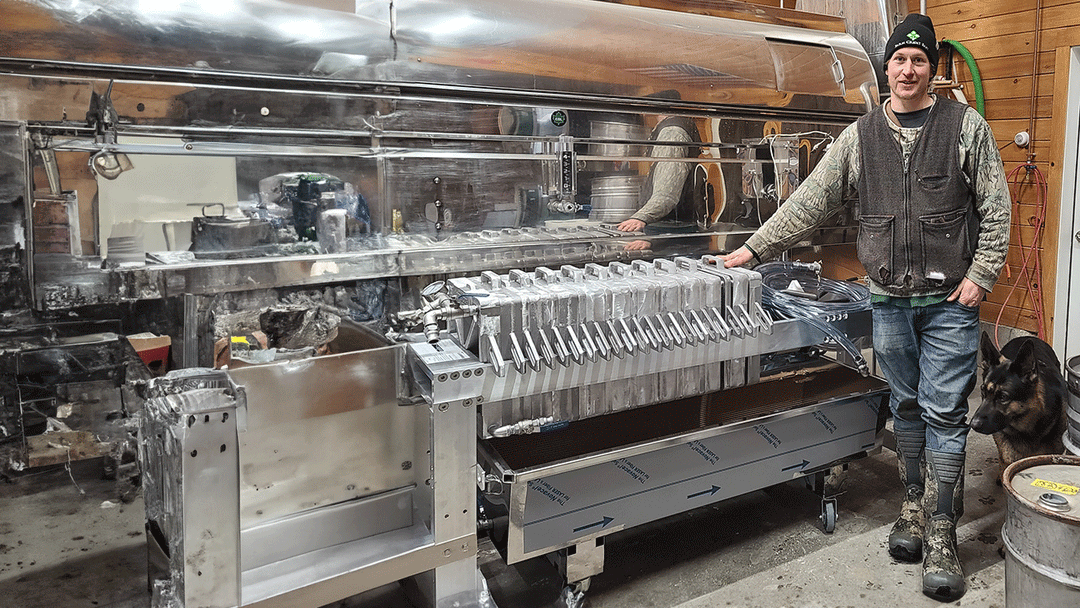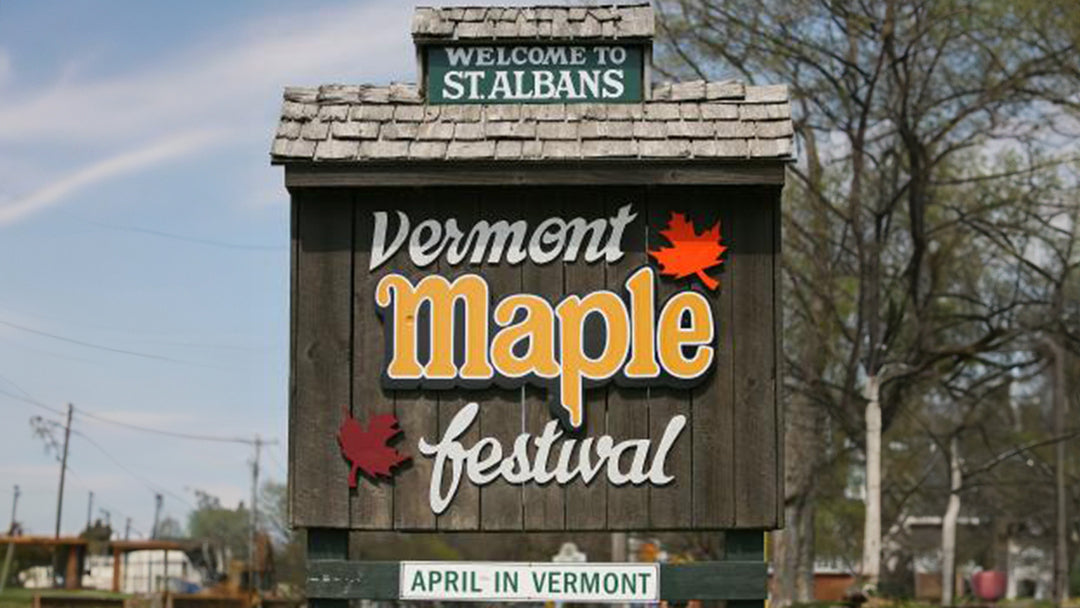Maple Season 2024

Welcome to our recap of the 2024 maple season at Carman Brook Farm! Once again, I'm delivering this mid-summer when the USDA NASS results report the entire state's production. This year, the word that defines our season is "dark"—dark syrup. The weather, as unpredictable as ever, played a significant role. An early warm spell set the tone for the season, darkening our syrup early and maintaining that trend throughout. Despite the weather challenges, we achieved nearly 94% of our average annual production. This success was greatly supported by the introduction of a new filter press system and significant improvements in our sugarwoods. Keep reading and we'll dive into the details of these advancements and the overall season at the farm and for Vermont, highlighting the key factors that shaped our 2024 maple season.
Reflections on the Season
Overall, we were happy with how the season turned out. Any time we can meet or approach an average year, it's considered a success, especially when we look back at challenging years like 2021 and 2012, where we only achieved 66% and 33% of an average crop, respectively. Despite the moment-to-moment challenges posed by the weather, looking back, we're counting our blessings. The unpredictable weather and early warm spell may have darkened our syrup, but it didn't dampen our spirits. The quality of the syrup remained high, and our production processes saw significant improvements, which we'll explore in greater detail throughout this recap.
Production Data 2024
As always, here's how this year stacked up to previous years with 2012 added in for context of what a really bad year looks like.
| Year | Hours Boiled | Start Date | End Date | Length of Season | Days Boiled | Gallons |
|---|---|---|---|---|---|---|
| 2024 | 139 | 2/9 | 4/10 | 62 | 40 | 6,534 |
| 2023 | 166 | 2/10 | 4/11 | 61 | 41 | 7,702 |
| 2022 | 156 | 2/18 | 4/11 | 52 | 32 | 6,994 |
| 2021* | 106 | 3/3 | 4/4 | 35 | 18 | 4,663 |
| 2020 | 235 | 2/24 | 4/4 | 41 | 32 | 7,513 |
| 2019 | 203 | 3/12 | 4/13 | 33 | 31 | 7,974 |
| 2018 | 197 | 2/16 | 4/21 | 65 | 45 | 7,050 |
| 2017 | 179 | 2/20 | 4/11 | 51 | 36 | 7,360 |
| 2016 | 247 | 2/21 | 4/17 | 57 | 37 | 6,989 |
| Average* | 181 | 25 day spread | 14 day spread | 51 | 35 | 6,975 |
| 2012 | 116 | 2/19 | 3/20 | 31 | 17 | 2,297 |
*2021 is the first year of production with our new efficient RO system.
At first glance, 2024 looks remarkably similar to 2023, and while this is true in many respects, there were some key differences related to climate that we'll expand on. One notable point is that while 2024 aligned very closely with 2023 in terms of the number of days we boiled, this year's sap runs were generally shorter. This is evident in the total hours boiled: 139 in 2024 versus 166 hours in 2023. If you've ever visited us, you'll know we talk about sap runs in detail, sometimes they're short, other times long. Despite these shorter sap runs, we managed to maintain a productive and high-quality season, highlighting the resilience and efficiency of our operations and especially by leaning forward and tapping in January.
Production Comparison with Previous Seasons
For our production comparison, we relied on data collected from the USDA National Agricultural Statistics Service (NASS) report for the 2024 season. Interestingly, while Vermont experienced a much stronger season in 2024 compared to 2023, our farm had the opposite trend.
In 2023, our production was well above average, whereas 2024 saw us producing just below our average annual yield. This divergence is noteworthy, especially when considering the broader statewide trends. According to the NASS report, Vermont produced an impressive 3.1 million gallons of syrup in 2024, compared to 2.6 million gallons in 2023.

2024 USDA NASS Maple Syrup Report
To provide context, many parts of Vermont in 2023 faced prolonged cold weather well into the spring. When the temperatures finally rose, they did so rapidly, which cut many farmers' seasons short. In contrast, the 2024 season saw a more balanced climate statewide, leading to an overall increase in syrup production. However, our specific conditions led to a slightly below-average yield for us.
Darker Syrup Production
In 2023, we classified our season as having an "Amber Rich Taste" profile. However, 2024 saw a marked shift towards producing darker syrup. This change intrigued us, prompting a deeper investigation into the underlying factors.
One significant factor was the climate. During my research, I came across several insightful articles from the Ohio State Maple Program that discuss the science behind tree budding and syrup color. When examining the accumulated growing degree days (AGDD), we noticed distinct patterns for 2023, 2024, and the 30-year average. Before delving into these patterns, let's first understand what GDDs are and why they matter.
Understanding Growing Degree Days (GDDs)
GDDs are a unit of measurement that helps scientists and farmers understand the physiological development of their crops. Essentially, GDDs are calculated based on the accumulation of heat units above a base reference temperature (in this case we used 32F). This measurement aligns closely with the initial “waking up” of trees during the growing season. GDDs provide a useful reference for tracking the progression of the maple season, highlighting spikes in warm temperatures and allowing comparisons to previous years and long-term averages.

Data from USA National Phenology Network 2024
Impact of GDD on Syrup Production
Referencing the AGDD graph above, you can see the representations of 2023, 2024, and the 30-year average. In 2024, we experienced unseasonably warm weather around the first week of March, putting us well above the historical averages. This early heat likely contributed to the darker syrup we produced this year.
The Ohio State Maple Program articles also offered fascinating insights into GDDs and tree bud break (bud break signals the end of a maple season). While GDDs are a useful indicator, they found that day length often plays a more crucial role in triggering bud break, especially when trees haven’t experienced the necessary chill period during winter. This finding aligns with our observations: despite variations in GDDs, our maple production season consistently ends around April 10th, particularly during mild winters.
GDDs provide a strong indicator for understanding trends in a maple season. As I discussed in my previous blog on maple syrup grades, the color change in maple syrup is influenced by bacterial activity in the tree sap, in which temperature plays an integral part. The unseasonably warm weather early this year led to an unusual amount of dark syrup production in 2024.
Updates in Production at the Farm

New Filter Press Implementation
This season, we introduced a new filter press system at Carman Brook Farm, significantly reducing one of our biggest headaches in day-to-day production. The new filter press has proven to be a game-changer for our operations. Unlike our previous setup, which required us to change filter papers 6-8 times a day during a big sap run, the new system allows us to filter multiple barrels of syrup without frequent interruptions to stop and clean. Quick handling of your sap is one of the biggest drivers of quality, and this improvement not only boosts our efficiency but also ensures a more consistent quality of syrup.
One of the remarkable features of the new filter press is its compact footprint. Despite being a much larger system, it occupies less space on the floor, which is crucial in our already tight production area. This space-saving design allows for better workflow and easier maneuverability within the sugarhouse. Overall, the new filter press has streamlined our operations, enabling us to maintain high standards of quality while increasing our productivity.
Spin Seal Technology in Sugarwoods
Another significant advancement this year was the adoption of spin seal technology for our food-grade plastic pipeline connections in the sugarwoods. Traditional methods, such as the saddle system, often pose challenges in terms of installation and security. The new spin seal technology uses friction welding to bond the plastic connections securely. This method is not only easier to install but also provides a more secure connection, reducing the likelihood of leaks.

Old style saddle on the left compared to the new spin seal on the right.
Friction welding involves the use of heat generated by friction to fuse two pieces of plastic together. This process creates a robust and leak-proof bond between the main and lateral lines in our sugarwoods. The transition to spin seal technology has saved us considerable time and effort tracking down and fixing leaks during the production season. The improved reliability of our pipeline system has resulted in fewer disruptions and more efficient sap collection.

A new spin seal over an old saddle hole saves us from having to do excess labor in switching to the new system.
Looking Ahead to 2025
Overall, we were not disappointed with the 2024 season. As farmers, we've learned to be flexible with what Mother Nature gives us, and this year was no exception. Despite the challenges and the variations in production compared to the previous year, we managed to improve our farm, make a respectable crop, and are excited to share it with our customers.

Work in the woods continues through the summer of 2024.

Using a shipping container to house our pumping station.
As we look forward to the summer, our focus is on further enhancing our sugarbush and fine-tuning our processes. These efforts include improving our pumphouse locations at key points in the forest to continue to improve quality and efficiency. We are optimistic about the future and eager to come back next season with even more efficient operations.
Don't forget to stay supplied with syrup throughout the year. We also encourage you to leave a comment with your observations or questions. Your feedback is valuable to us, and we love hearing from our community. Here's to another successful maple season and many more in the future!






Can’t wait to taste the 2024 maple syrup! We both fondly remember the days (back in the 1970s) when we could get bulk “Grade D” super-dark maple syrup at the local whole food co-op. . . The Darker the Better 😍
Keep up the great job & great produce. . . “Bitter/tart” sounds like right down our taste bud alley! 🍁🍎❤️
Leave a comment